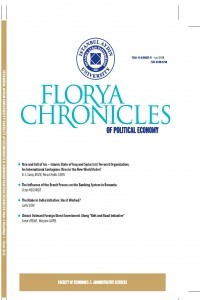A Critical Approach to the Corporate Insolvency in Romania
A Critical Approach to the Corporate Insolvency in Romania
A critical moment in the existence of an economic entity is the deterioration of its financial situation and the advent of a liquidity crisis that could lead to the establishment of debt payment incapacity. Through this paper, we analyse the financial situation of companies before the moment of entry into insolvency and during insolvency proceedings, and then we compare them with non-distressed companies. Our purpose is to debate the problem of the prediction of insolvency in terms of symptoms and methods of assessment of the risk of insolvency, taking into account a sample of companies from Romania that are listed on the Bucharest Stock Exchange Market. In order to reveal the most significant indicators that describe the distressed companies, we conducted a comparative analysis of some existing models to measure the bankruptcy riskm with a focus on testing their applicability and developing a new model appropriate for the Romanian business environment
Keywords:
Insolvency, Insolvency Risk, Financial Information, Bankruptcy Prediction Models, Artificial Neural Networks Romania.,
___
- Altman, E. I. (1968). Financial ratios, discriminant analysis and the prediction of corporate bankruptcy. The Journal of Finance, (4), 589-609.
- Altman, E. I., Sabato, G., & Wilson, N. (2010). The value of non-financial information in small and medium-sized enterprise risk management. The Journal of Credit Risk, 6(2), 1-33.
- Al-Kassar, T. A., & Soileau, J. S. (2014). Financial performance evaluation and bankruptcy prediction (failure). Arab Economics and Business Journal, 9, 147-155.
- Anghel, I. (2002). Falimentul. Radiografie şi predicţie. Bucharest: Editura Economică.
- Bircea, I. (2012). Financial diagnosis of distressed companies. Procedia Economics and Finance, 3, 1134-1140.
- Chung, K.-C., Tan, S. S., & Holdsworth, D. K. (2008). Insolvency prediction model using multivariate discriminant analysis and artificial neural network for the finance industry in New Zealand. International Journal of Business and Management, 3(1), 19-29.
- Cimpoeru, S. (2014). Scoring functions and bankruptcy prediction models – Case study for Romanian companies. Procedia Economics and Finance, 10, 217-226.
- Fisher, T. C. G, & Martel, J. (2000). The firm’s reorganization decision: Empirical evidence from Canada. Social Science Research Network. Retrieved from http://dx.doi.org/10.2139/ssrn.249950.
- Gitman, L. J., & Zutter, C. J. (2011). Principles of managerial finance (13th ed.). Boston: Prentice Hall.
- Hamdi, M. (2012). Prediction of financial distress for Tunisian firms: A comparative study between financial analysis and neuronal analysis. Business Intelligence Journal, 5(2), 374-382.
- Huang, S. Y., Chiu, A.-A., & Wang, B.-C. (2012). Applying intellectual capital on financial distress prediction model in Taiwan information technology and electronic industry. International Journal of Advancements in Computing Technology, (8), 270-280.
- Laitinen, E. K., Lukason, O., & Suvas, A. (2014). Behaviour of financial ratios in firm failure process: An international comparison. (2), 122-131.
- Lin, F., Liang, D., & Chu, W.-S. (2010). The role of non-financial features related to corporate governance in business crisis prediction. Journal of Marine Science and Technology, (4), 504-513.
- Martin, A., Balaji, S., & Venkatesan, V. P. (2012). Effective prediction of bankruptcy based on the qualitative factors using FID3 algorithm. International Journal of Computer Applications, (21), 28-32.
- Mehrazin, A., Taghipour, M., Froutan, O., Ghabdian, B., & Soleimani, H. (2013). Radial basis function in artificial neural network for prediction of bankruptcy. International Business Research, 6(8), 121-128.
- Mironiuc, M., & Taran, A. (2015). The significance of financial and non-financial information in insolvency risk detection. Paper presented at the 4th World Conference on Business, Economics and Management (WCBEM 2015), Kusadasi, Izmir, Turkey, April May 2, 2015. Accepted for publishing in Elsevier Procedia Economics and Finance (ISSN: 2212-5671).
- Newton, G. W. (2009). Bankruptcy and insolvency accounting (7th ed., vol. 1). New Jersey: John Wiley & Sons, Inc.
- Pacelli, V., & Azzollini, M. (2011). An artificial neural network approach for credit risk management. Journal of Intelligent Learning Systems and Applications, 3, 103-112.
- Ramayah, T., Ahmad, N. H., Halim, H. A., Zainal, S. R. M., & Lo, M.-C. (2010) Discriminant analysis: An illustrated African Journal of Business Management, example. (9), 1654-1667.
- Robu, I.-B., Balan, C. B., & Jaba, E. (2012). The estimation of the going concern ability of quoted companies using duration models. Procedia – Social and Behavioral Sciences, (62), 876-880.
- Robu, M.-A., Mironiuc, M., & Robu, I.-B. (2012). Un model practic pentru testarea ipotezei de “going-concern” în cadrul misiunii de audit financiar pentru firmele româneşti cotate. Audit financiar, 10(86-2), 13-24.
- Sayari, N., & Simga Mugan, F. N. C. (2013). Cash flow statement as an evidence for financial distress. Universal Journal of Accounting and Finance, 1(3), 95-103.
- Šarlija, N., & Jeger, M. (2011). Comparing financial distress prediction models before and during recession. Croatian Operational Research Review, 2, 133-143.
- Wilson, N., & Altanlar, A. (2014). Company failure prediction with limited information: Newly incorporated companies. Journal of the Operational Research Society, 65, 252-264.
- Zhang, G., Hu, M. Y., Patuwo, B. E., & Indro, D. C. (1999). Artificial neural networks in bankruptcy prediction: General framework and cross-validation analysis. European Journal of Operational Research, (116), 16-32.
- ISSN: 2149-5750
- Yayın Aralığı: Yılda 2 Sayı
- Başlangıç: 2015
- Yayıncı: İstanbul Aydın Üniversitesi
Sayıdaki Diğer Makaleler
A Critical Approach to the Corporate Insolvency in Romania
Changes in Population Age Structure and Economic Development: The Case of Bangladesh
Rashed Al Mahmud TITUMIR, Zahidur RAHMAN
Turkey in Africa: Lessons in Political Economy
